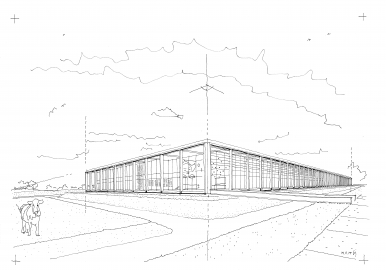Cheese Dairy
CONO Cheesemakers wished in 2006 to replace the current cheese dairy and stay in the Beemster Polder, after all the production of the Beemsterkaas belongs in the Beemster Polder. Beemster (1612) is most famous Dutch reclaimed land, since 1999 a World Heritage Site by UNESCO. The design for the cheese dairy had to be indebted to the DNA of the polder .
A world heritage is to be "a masterpiece or characteristic of an important period in history." The new building should be able to compete with the core qualities associated with the design of the Beemster, it says in the guidelines of UNESCO. Aldous Huxley wrote in 1926 as an outsider in his travels striking about the Beemster Polder: "In a country where the ideal plane meets geometry books, roads and locks are the shortest distance between two points. (..) Inevitably lead the laws of perspective, the long roads and the shining water to a vanishing point. (..) What the farmhouse fits perfectly into the geometric system! (..) "
The reclaimed land was developed in 1612 and based on the ideas at the time of the Renaissance. In Italy, at that time the texts of Vitruvius studied from Roman times and reinterpreted by architects and urban planners. Surveying and the central perspective invention set makers are able to draw a perfect plan and visualize spatial.
Perspective, the key instrument in this surveying and cartographic timeframe is highly utilized in the design for CONO Cheesemakers.
On the polder scale the design of the cheese dairy serves the openness of the landscape.
Mathematical study shows that a narrow elongated building the most foresees the openness of the landscape. The landscraper uses the depth of the lot, looks small from the road and leaves room for the landscape and the cloudy sky.
The locks are restored on the scale of the plot as they appear on the copper engraving from 1612, is the lot size of 75 meters width readable again. The buildings thus be recognizable again in their lot with plenty of intermediate size, which makes you could see the horizon anytime.
The farm house, the building piece of the Beemster, composed upon the characteristics of the Beemster polder, as the geometry in the construction of the square with the pyramidal roof and the proportions of the golden section. The farmhouse is part of the landscape, but reversed the farmhouse enhances the landscape. The design of the cheese dairy tries just as in the farmhouse to establish the synergy of the use, the geometry of the structure and the connection with the landscape in its own way.
The depth of the lot is used for a series of functions: the public functions (reception, cheese shop, boardroom) are located at the front on the road and production parts with the cheese dairy, the brine room, the warehouse and the shipping are organized in the depth of plot.
The program for the cheese dairy is robust, measuring 15,000 m2 and would have to be fitted into an open landscape of the Beemster Polder, since 1999 UNESCO World Cultural. The design should be able to compete with the core qualities associated with the design of the Beemster, it says in the guidelines of UNESCO. The core strengths of the Beemster are the openness of the ideal landscape, typical ribbon subdivision and the geometric order. Design research has led to the steps in the design process, always with convincing answers given to preserve and even strengthen the core qualities of the Beemster Polder.
In the design of the cheese dairy an attempt has been made to bring about a synergy of the use, the geometrical construction and the connection with the landscape, so typical of the farmhouse, in their own way. By composing the building as a spatial structure with a strong rhythm in the depth of the lot, completely filled with glass surfaces. The cheese making is visible in the landscape by its transparency and vice versa the landscape seems to walk into the building. CONO Cheesemakers has the ambition to be the most sustainable cheese dairy in the world. Design and sustainability come together in the colonnade, talking in a modern way the language of the Renaissance and at the same time functions as the blinds of the glass facades, which completely let daylight in. With the choices for the materials, the environmental print has been mapped. The colonnade is built from laminated wood with FSC label. The glass facades are mounted beneath the overhang and finished with a rubber profile. The roof is finished with PVC, 30 years maintenance free.

 © Luuk Kramer
© Luuk Kramer
 © Luuk Kramer
© Luuk Kramer
 © Luuk Kramer
© Luuk Kramer
 © Luuk Kramer
© Luuk Kramer
 © Luuk Kramer
© Luuk Kramer







